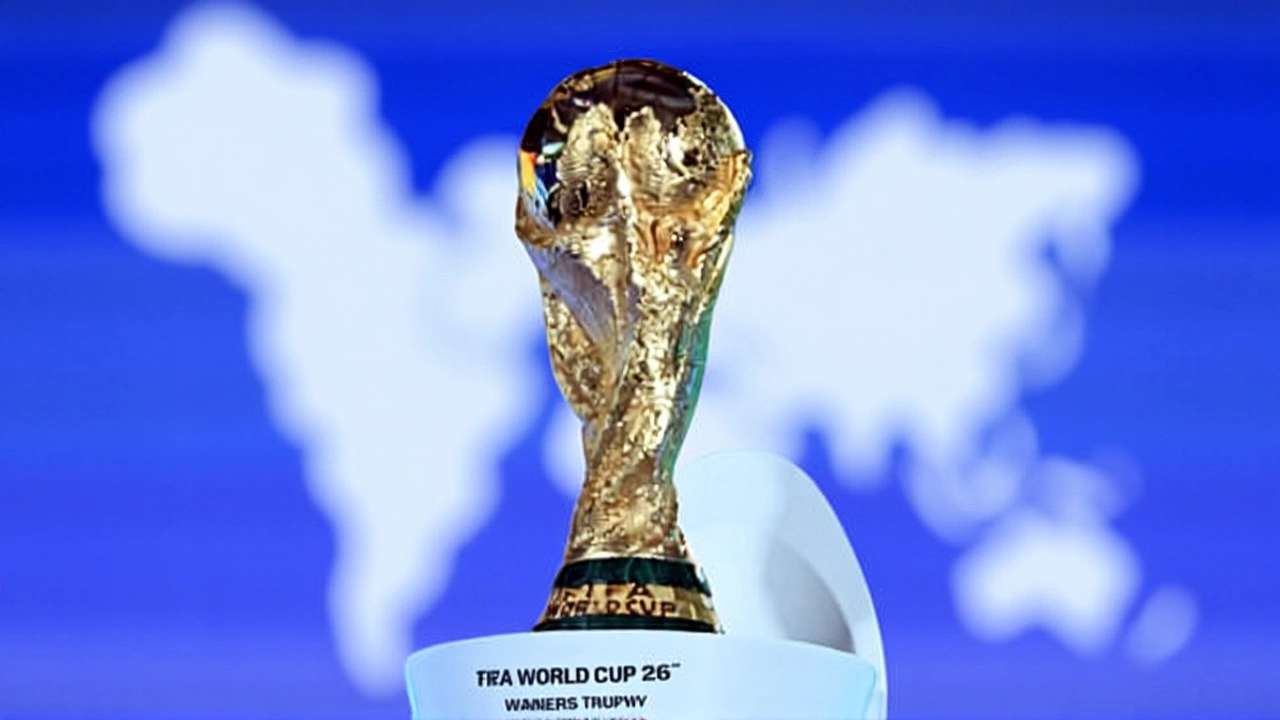The final two tickets to the 2026 FIFA World CupCanada, Mexico, and the United States won’t be decided in a single knockout match — they’ll be fought over in a high-stakes, three-game tournament hosted in Mexico. From March 23 to March 31, 2026, six national teams from five continents will battle in a newly structured inter-confederation play-off, marking the most complex qualification finale in World Cup history. This isn’t just a formality. It’s the last chance for teams like Iraq, Democratic Republic of the Congo, and Jamaica to prove they belong on football’s biggest stage — and the pressure? It’s unbearable.
How the New Play-Off Format Works
Forget the old one-off matches. The 2026 edition expands the play-off into two brackets of three teams each, with a semi-final and final in each. The winner of each bracket claims a World Cup spot. Seeding is based on the FIFA Men’s World Rankings as of late 2025, meaning higher-ranked teams skip the semi-final and go straight to the final. Lower-ranked sides must survive a do-or-die opener just to get a shot at glory.
Bracket 1 features Bolivia and Suriname in the semi-final, with the winner facing Iraq in the final. Bracket 2 pits Jamaica against the yet-undetermined Oceania Football Confederation (OFC) champion, with the victor advancing to face Democratic Republic of the Congo. The structure feels like a mini-tournament — intense, unpredictable, and brutal.
Who’s Already In?
Three teams have already punched their tickets through their continental qualifiers:
- Iraq (AFC) — won their fifth-round playoff on November 18, 2025
- Democratic Republic of the Congo (CAF) — clinched their spot on November 16, 2025 after a tense group-stage run
- Jamaica (CONCACAF) — secured their place on November 18, 2025 as one of the best runners-up
Two more are confirmed but without exact qualification dates: Bolivia (CONMEBOL) and Suriname (CONCACAF). The sixth and final participant? The OFC representative — likely either New Zealand or Papua New Guinea — won’t be known until their final qualifier wraps up in early 2026. That uncertainty adds another layer of drama.
Why This Format? Why Now?
This isn’t arbitrary. With the World Cup expanding from 32 to 48 teams, FIFA needed more pathways for smaller confederations to compete. The old system — two teams, one match, winner takes all — was too simplistic for this new era. Now, teams from Oceania and Asia have a fairer shot. It’s not perfect, but it’s more inclusive. The fact that Suriname, a nation of just 600,000 people, is in this tournament speaks volumes. So is Democratic Republic of the Congo’s return after a 12-year absence.
And let’s not forget the logistical angle. Hosting this in Mexico serves as a dress rehearsal for the main event. The stadiums, transportation, security protocols — all get tested under real conditions. It’s smart. It’s practical. And honestly? A little brilliant.
What’s at Stake Beyond the Tickets
For Jamaica, this is about legacy. Their last World Cup appearance was in 1998. A run here could reignite a national passion that’s been simmering since the Reggae Boyz stunned the world. For Iraq, it’s redemption after decades of political turmoil and footballing isolation. And for Bolivia, playing in the high-altitude stadiums of Mexico might just be the perfect test before facing Europe’s heavyweights in June.
The financial stakes are massive too. A World Cup appearance means hundreds of millions in broadcast rights, sponsorships, and tourism. For nations like Suriname and the OFC team, this isn’t just about pride — it’s about survival. Football funding in the Pacific and Caribbean often depends on World Cup exposure. One tournament can change a federation’s future.

What’s Next?
The next 15 months will be a whirlwind. The OFC qualifier concludes in early 2026, likely between New Zealand and Tahiti or Fiji. Then comes the draw — which will determine exact match dates and venues in Mexico. Expect stadiums in Monterrey, Guadalajara, or possibly Tijuana to be selected. The final two teams will join the 46 already qualified sides in the World Cup draw in December 2025.
And don’t forget the European play-offs — those run from March 26 to March 31, 2026, overlapping with the inter-confederation tournament. That means fans will be glued to screens across three continents simultaneously. It’s chaos. It’s beautiful.
Behind the Scenes: The Road to 2026
The qualification process began in March 2025, with Europe kicking things off. Poland beat Lithuania 2-0 on March 21, 2025. Cyprus held San Marino to a draw. By June, Croatia crushed the Czech Republic 5-1. Spain and Turkey clashed in a tense November 18 match that ended 3-2. These results shaped the rankings that now determine seeding for the play-offs.
The 2026 World Cup itself will span 104 matches across 16 venues, from Toronto’s BMO Field to Mexico City’s Estadio Azteca and the new Las Vegas stadium. The final on July 19, 2026, will be watched by over a billion people. But before that, six teams will fight for two spots in a tiny, intense tournament in Mexico — where one loss ends everything.
Frequently Asked Questions
How does the new play-off format benefit smaller nations like Suriname or the OFC team?
The new format gives smaller teams a better chance by allowing them to play multiple games, not just one. A single-match elimination often favors the higher-ranked side due to pressure and luck. Now, a team like Suriname can recover from a poor first match and still advance. It also increases exposure — broadcasters are more likely to cover a three-game tournament than a one-off. For nations with limited resources, this means more revenue, more visibility, and a real shot at global recognition.
Why is Mexico hosting the play-offs instead of the U.S. or Canada?
Mexico was chosen because of its proven infrastructure, experience hosting major tournaments (including the 1970 and 1986 World Cups), and logistical proximity to the U.S. and Canada. Hosting the play-offs there allows FIFA to test border security, fan travel, and media operations across North America before the main event. It also gives Mexican fans a preview of the World Cup atmosphere — and boosts tourism ahead of June.
What happens if a team qualifies for both the play-offs and the World Cup through their confederation?
That’s not possible. Teams qualify for the play-offs only if they don’t make it directly through their continental tournament. For example, Jamaica didn’t finish top two in their CONCACAF group, so they entered the play-off path. If they had finished first or second, they’d have qualified automatically. The system is designed to avoid overlap — every team in the play-offs is there because they missed direct qualification.
Who are the biggest underdogs in this play-off tournament?
Suriname and the OFC qualifier are the clear underdogs. Suriname has never reached a World Cup and has only 15,000 registered players. The OFC team — likely New Zealand — has a stronger pedigree but faces a massive gap in resources compared to CONMEBOL and AFC sides. Even if New Zealand wins their bracket, they’d face Iraq or DR Congo — both with deeper squads and more international experience. But football thrives on upsets. One moment of brilliance, and history is made.
Will fans be able to attend the play-off matches in Mexico?
Yes. FIFA typically opens ticket sales for play-off matches to the general public, with priority given to fans of the participating nations. Expect demand to be high, especially from Jamaica, Iraq, and Bolivia, whose diasporas are large and passionate. Matches will likely be held in mid-sized stadiums like Estadio BBVA in Monterrey or Estadio Jalisco in Guadalajara, offering an intimate, electric atmosphere — far different from the massive venues of the main tournament.
What’s the historical significance of this play-off tournament?
This is the first time the inter-confederation play-offs have used a three-team bracket format. Previous editions — like the 2022 playoffs between Australia and Peru — were single matches. The 2026 version reflects FIFA’s push for inclusivity and fairness in an expanded tournament. It also sets a precedent for future World Cups. If successful, this format could become permanent, giving every confederation a more equitable shot at the global stage — and that’s a win for football as a whole.
